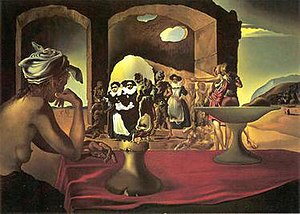Slave Market with the Disappearing Bust of Voltaire
This article needs additional citations for verification. (January 2021) |
| Slave Market with the Disappearing Bust of Voltaire | |
|---|---|
 | |
| Artist | Salvador Dalí |
| Year | 1940 |
| Medium | Oil on canvas |
| Dimensions | 47 cm × 66 cm (18+1⁄2 in × 26 in) |
| Location | Salvador Dalí Museum, St. Petersburg, Florida |
Slave Market with the Disappearing Bust of Voltaire (1940) is a painting by Spanish Surrealist Salvador Dalí. The painting depicts a slave market, while a woman at a booth watches the people. A variety of people seem to make up the face of Voltaire, while the face seems to be positioned on an object to form a bust of Voltaire. Voltaire was a French writer and philosopher known for his opposition to slavery.
The painting was completed in 1940 in oil on canvas. Dalí describes his work on the painting "to make the abnormal look normal and the normal look abnormal."[1] He used a technique so called "double mage", where one form contains two or more images. In the painting, two women dressed in seventeenth-century costumes form the face of Jean-Antoine Houdon's bust of Voltaire.[2]
See also[edit]
References[edit]
- ^ Beech, Martin (Oct 27, 2011). The Physics of Invisibility: A Story of Light and Deception. Springer Science & Business Media. p. 24. ISBN 9781461406150.
- ^ Moorhouse, Paul (2001). Dali (Reprinted 2004 ed.). London: PRC Publishing Limited. p. 23. ISBN 978-1-85648-674-3. Retrieved 5 June 2024.
VanRullen R, Koch Ch. Is perception discrete or continuous ? Trends Cogn Sci.2003;7(5):207-213.
Further reading[edit]
- Costandi, Mo. "The Ghostly Gaze and the Disappearing Bust of Voltaire". The Guardian (U.S. Edition). Monday 19 September 2011 10.48 EDT.
